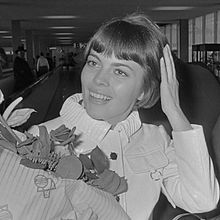Behind the scenes of Paris
Behind the scenes in Paris is a hit that was composed in 1969 by Christian Bruhn for Mireille Mathieu . Georg Buschor wrote the text . The song was produced by Christian Bruhn and Gerhard Hämmerling .
Emergence
Christian Bruhn and Georg Buschor tried in vain to win Mireille Mathieu for the German-speaking market and sent several song ideas to their French record company without receiving any answers. The music publisher Gerhard Hämmerling finally made contact with Mathieu's producer Johnny Stark , who then traveled to Bruhn and Buschor in Munich. Bruhn introduced the two tracks Martin and Stockholm to Stark , which should appear on a first single. Stark liked the title Martin , but Stockholm didn't like it at all. To prevent the project from going through, Buschor rushed forward and claimed there was another song called Behind the Scenes of Paris, of which only the title was known. Bruhn began to improvise and after a few bars Stark jumped up and exclaimed enthusiastically “c'est ça! Adjustment! ”(“ That's it! ”).
The single was recorded in the Ariola studio in Berlin , and the recording of Behind the Scenes in Paris took three hours for Mireille Mathieu, who was ignorant of the German language.
content
The song transfigured the city of Paris as a romantic place of longing, for which a stylistic device was used, for example, by sprinkling French vocabulary into the German text. Otherwise, the song was “garnished with everything that the French cliché box had to offer, both lyrically and musically”. In addition to clichéd text like
- And the Seine flows forever, and l'amour is eternal.
- It will always stay that way
- day in, day out, toujours
this stylistic device come as the use of a Musette - Accordion to bear the typical of this style of music in ⁶ / ₈ clock arpeggios plays.
successes
Behind the scenes in Paris , the first German-language hit was Mireille Mathieu. In the German music charts , the single with Martin on the B-side reached number five and the Austrian number four. It also reached number five in the Belgian music charts and number 15 in the Netherlands . After the success of the single, the LP Mireille Mireille was produced with six German and six French songs.
The song was covered several times , as early as 1969 by Mathieu himself as L'amour de Paris . In the same year, Swedish versions of Bibi Johns and Birthe Kjær and Dutch versions of Joyce Suma and Truus appeared , followed by a Danish version of Lis Evers in 1970 . Another Dutch recording by Wendy van Wanten followed in 1998, Séverine recorded a French version in 2001, and another German version in 2006.
Remarks
- ↑ Christian Bruhn: Marble, Stone and Lovesickness . Schwarzkopf & Schwarzkopf, Berlin 2005, p. 171
- ↑ Frauke Schmitz-Gropengießer: "Behind the Scenes of Paris". German hits à la française . In: Michael Fischer, Fernand Hörner (Ed.): Song and popular culture. German-French music transfers. (= Yearbook of the German Folk Song Archive Freiburg , Volume 57). Waxmann 2012, pp. 219-246. (here 238 f.)
- ↑ Martin Lücke: Behind the Scenes of Paris . In: Ingo Grabowski, Martin Lücke: The 100 hits of the century . Europäische Verlagsanstalt, Hamburg 2008, pp. 141–143.
- ↑ Chart data
- ↑ Cover versions
